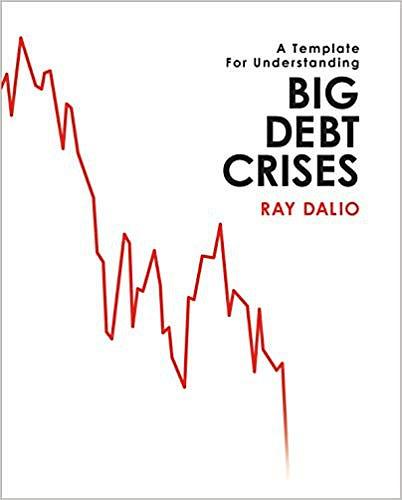章节目录
Acknowledgement
Introduction 7
Part 1: The Archetypal Big Debt Cycle 9
How I Think about Credit and Debt 9
The Template for the Archetypal Long-Term/Big Debt Cycle 13
Our Examination of the Cycle 13
The Phases of the Classic Deflationary Debt Cycle 16
-The Early Part of the Cycle 16
-The Bubble 16
-The Top 21
-The "Depression" 23
-The "Beautiful Deleveraging" 32
-"Pushing on a String" 35
-Normalization 38
Inflationary Depressions and Currency Crises 39
The Phases of the Classic Inflationary Debt Cycle 41
-The Early Part of the Cycle 41
-The Bubble 42
-The Top and Currency Defense 45
-The Depression (Often When the Currency Is Let Go) 49
-Normalization 54
The Spiral from a More Transitory Inflationary
Depression to Hyperinflation 58
War Economies 61
In Summary 64
PART 2: Detailed Case Studies
German Debt Crisis and Hyperinflation (l918-1924}
US Debt Crisis and Adiustment (1928-1937)
US Debt Crisis and Adiustment (2007-2011)
PART 3: Compendium of 48 Case Studies
Glossary of Key Economic Terms
Primarily Domestic Currency Debt Crises
Non-Domestic Currency Debt Crises
Appendix: Macroprudential Policies
内容简介
"Ray Dalio's excellent study provides an innovative way of thinking about debt crises and the policy response." - Ben Bernanke
"Ray Dalio's book is must reading for anyone who aspires to prevent or manage through the next financial crisis." - Larry Summers
"A terrific piece of work from one of the world's top investors who has devoted his life to understanding markets and demonstrated that understanding by navigating the 2008 financial crisis well." - Hank Paulson
"An outstanding history of financial crises, including the devastating crisis of 2008, with a very valuable framework for understanding why the engine of the financial system occasionally breaks down, and what types of policy actions by central banks and governments are necessary to resolve systemic financial crises. This should serve as a play book for future policy makers, with practical guidance about what to do and what not to do." - Tim Geithner
On the 10th anniversary of the 2008 financial crisis, one of the world's most successful investors, Ray Dalio, shares his unique template for how debt crises work and principles for dealing with them well. This template allowed his firm, Bridgewater Associates, to anticipate events and navigate them well while others struggled badly.
As he explained in his #1 New York Times Bestseller, Principles: Life & Work, Dalio believes that most everything happens over and over again through time so that by studying their patterns one can understand the cause-effect relationships behind them and develop principles for dealing with them well. In this 3-part research series, he does that for big debt crises and shares his template in the hopes reducing the chances of big debt crises happening and helping them be better managed in the future.
The template comes in three parts provided in three books: 1) The Archetypal Big Debt Cycle (which explains the template), 2) 3 Detailed Cases (which examines in depth the 2008 financial crisis, the 1930's Great Depression, and the 1920's inflationary depression of Germany's Weimar Republic), and 3) Compendium of 48 Cases (which is a compendium of charts and brief descriptions of the worst debt crises of the last 100 years). Whether you're an investor, a policy maker, or are simply interested, the unconventional perspective of one of the few people who navigated the crises successfully, A Template for Understanding Big Debt Crises will help you understand the economy and markets in revealing new ways.
下载说明
1、Big Debt Crises是作者Ray Dalio创作的原创作品,下载链接均为网友上传的网盘链接!
2、相识电子书提供优质免费的txt、pdf等下载链接,所有电子书均为完整版!
下载链接
热门评论
-
[已注销]的评论其实去杠杆还有第五个方法,消灭债权人 from weibo
-
指上弹冰的评论通过对历史上债务危机的研究,Ray Dalio和桥水分享了理解债务危机运行的模板。书中将债务危机分为两大类:通缩型债务危机(本币计价债务)和通胀型债务危机(外币计价债务,不容易化解),而减债/去杠杆的措施Ray在之前提过很多次,分别是紧缩、债务违约/重组、QE和印钞票、财富转移再分配(这一条是新增加的),如果政策制定者能够快速反应并运用好手中工具,能够实现化解债务危机。其中对魏玛德国恶性通胀、大萧条和次贷危机进行了非常详细的解读,可以感觉出来Ray对次贷危机后美联储和财政部的应对措施极其欣赏。附录介绍的宏观审慎政策工具,本质就是指导信贷局部调整,其中一条Changing accounting rules on different assets,这就是20天前人民银行重启的“逆周期因子”吧。。
-
早就想叫白玉狐的评论结合现实看,更为有趣。
-
Future<T>的评论应该是我第一本完整看完的英文版经济学书。之前没有经济学基础,经济学方面的词汇量也不够,还是挺吃力的,很多术语只能查 wiki 或 investopedia,前前后后花了有半年时间,总得来说觉得值。最重要的是 Dalio 提供了三次金融危机的非常详细的描述,还有精确到天的报纸的摘要,简直可以每天看一部分然后像真实体验过一样。之后看类似危机分析的书可以拿来做对照。
-
之如的评论Simply the best hypothesis, and proven.
-
A-Xun的评论后面的广告有点出戏……
-
yusen的评论没时间的话主要读第一部分和2007-2008的案例就好了,可是人类什么时候会从中吸取教训呢?
-
Renco的评论这是一本全景纪实书,反映了桥水对债务危机的研究。虽然是一家之言,但是可以拿来跟《大而不倒》交叉看。第一部分的理论和第二部分的案例教学是精华,Ray保持了足够的中立性。
-
NEVER4U的评论Type of books only Dalio can write
-
tzr的评论草草读过一遍,感觉第二部分,三个案例部分很好。最后第三部分就没有什么看的必要了。
-
长风的评论关于宏观经济和货币政策。逻辑清晰,信息量很大,值得再读
-
会微积分的猫的评论囫囵吞枣的第一遍
-
streamy的评论神作。洞见。
-
知未的评论当时特别担心经济形势找来读的,很多数字图表近乎教科书。所以读得也缓慢。读到德国魏玛共和国的案例那里就没有读下去了。
-
zhifeige的评论Ray Dalio的现实主义贯穿始终,在解决债务危机面前,道德是次要的。
-
XenilugJ的评论干货满满。deflationary/inflationary debt crises的两个框架搭得很好,三个具体例子(德国1918,美国1928,美国2007)是对框架详尽的运用,分析详细,包括从宏观、政策制定者、和普罗大众的各个角度进行,比较全面。扫过后面48个例子概况。
-
周游雪场的评论魏玛共和国和29年大萧条的例子非常清晰。学了这么多年二战史,竟然是看了dalio的书之后才终于明白了一直不明白的事。算是一个意外的收获。在理论方面,dalio的模型其实没有什么特殊的。只是更量化统一的说明了,在危机时放水时必须的,货币贬值是必须的。其他的道德和政治争议,比如放水是不是便宜了黑心资本家,比如说是不是要给政府或银行一个教训,这些争论都要往后放。因为在当下,这些因素都只会让经济每况愈下,无法回复。但他整理的历史也侧面说明了,在真实世界里,做“正确的放水决定”是很困难的,政策执行人常常会反复,所以一旦进入危机周期,每一次不彻底的政策带来的部分反弹,都难掩整体的下行趋势。
-
蒋川的评论ray dalio还用说什么
-
mi的评论简单又能把事情说明白
-
米占米占的评论It’s an incredible skill to explain models and theories in intuitive words. Only someone sees through it can achieve that. Note: There are two kind of relationships. Cooperative-competitive or mutually threatening. Either side can force the second path onto the other side. But it takes both sides to go down the win-win path.

